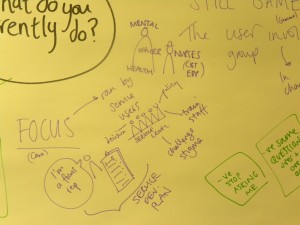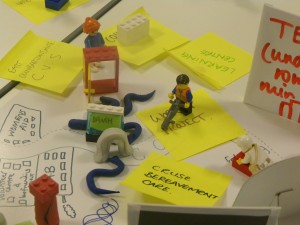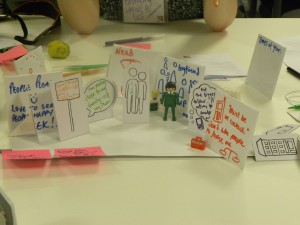This project is all about empowering people to think about all of the positive assets that they have in their lives and communities. It begins with the premise that, “you can’t know what you need, until you know what you have”.
In order to start finding out about what exists in the local area, the project work began mid-June with a workshop that aimed to introduce staff (mental health practitioners from the voluntary, private and public sectors) to asset mapping as a way of working.
Facilitated by SNOOK (http://wearesnook.com/snook/), we spent time with the staff to share experience and practice across the different agencies, as well as exploring how this way of working is different from the techniques that they currently use to design services around the people that they support.
We worked together to have a go at asset mapping in two different ways. Firstly, to create a community map:
Then to explore the use of asset mapping for person-centred planning (where we worked together to create a person-centred map for me!):
Many of the participants thought that the asset mapping method could work well alongside the approaches that they are already using, although they did come up with applications that we’d never thought of! Ideas ranged from using the process as a useful way to reflect on progress with people using services, to seeing the world directly through the eyes of the user.
There were lots of things that people liked about the use of the tool. These included:
- working well as an individual recording tool
- good for training staff
- provided a new way to access thoughts and feelings (which can be hard when you are obsessed with thoughts and feelings)
- helping to unstick people and staff
- capturing the conversation
- thinking about different routes to get to a solution.
- it might paint quite a stark picture for some people
- the need to make sure that the person/people are in the right place in the recovery journey to engage in the process
- it can generally be quite hard to get people involved
- hard to identify assets.
Staff could see how the process linked into work that they already do, but thought that it was different in the following ways:
- it’s 3D
- very visual
- bespoke (different every time, depending on who is involved)
- holistic
- inclusive
- fun
This workshop and feedback was really useful in terms of designing the next few sessions, which will bring together people using services and practitioners.
Over the coming weeks we’ll be talking to lots of people who use services, gathering their thoughts, ideas and experiences in the lead up to these sessions, where we’ll work on mapping out the local area in greater detail. We’re hoping to be able to determine the difference between individual assets that people use to support themselves, and the assets that exist locally – with a view to identifying the gaps and opportunities that exist.
Watch this space!
You can view the full range of pictures from this first event here:


